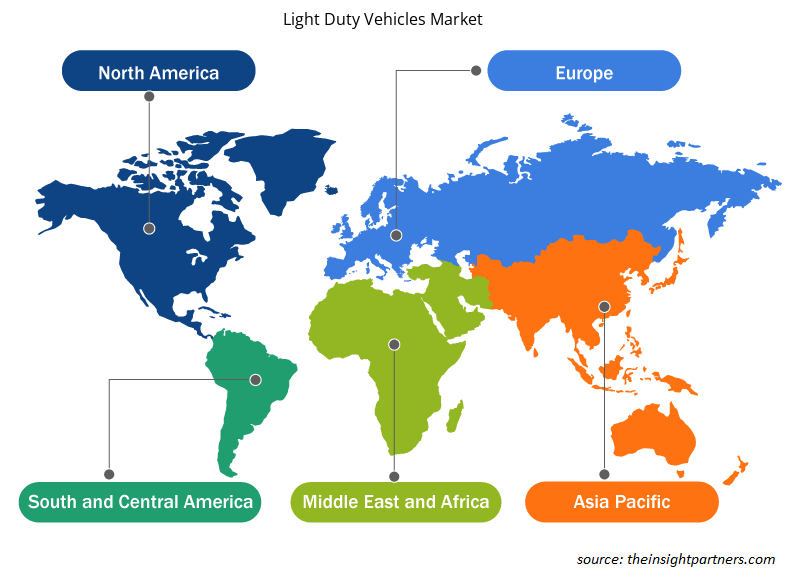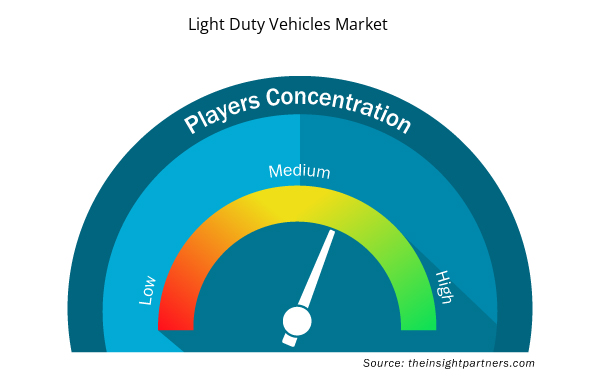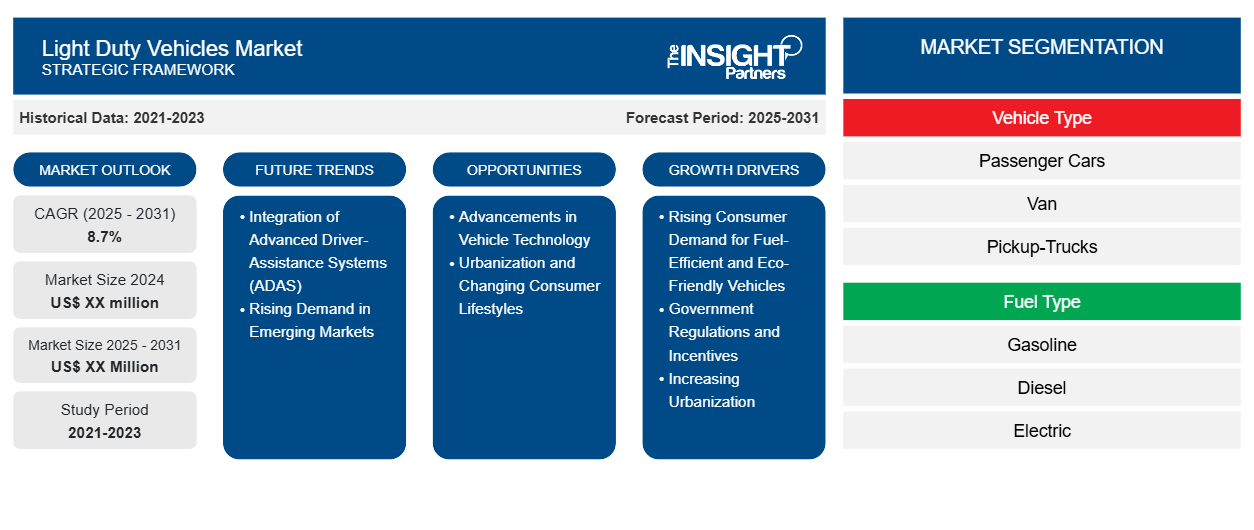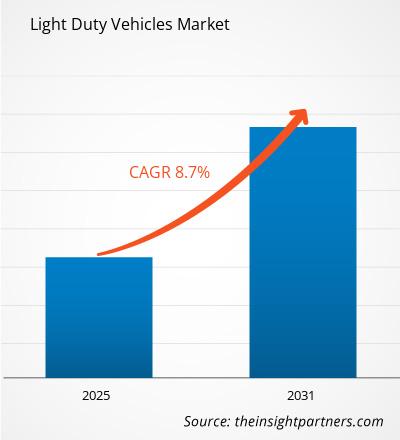Se espera que el mercado de vehículos ligeros registre una CAGR del 8,7 % entre 2023 y 2031, con un tamaño de mercado que se expandirá de US$ XX millones en 2023 a US$ XX millones en 2031.
El informe está segmentado por tipo de vehículo (automóviles de pasajeros, furgonetas, camionetas pickup, vehículos comerciales ligeros (LCV)); tipo de combustible (gasolina, diésel, eléctrico, otros); tipo de transmisión (manual, automática). El análisis global se desglosa aún más a nivel regional y por países principales. El informe ofrece el valor en USD para el análisis y los segmentos anteriores.
Propósito del Informe
El informe Light Duty Vehicles Market de The Insight Partners tiene como objetivo describir el panorama actual y el crecimiento futuro, los principales factores impulsores, los desafíos y las oportunidades. Esto proporcionará información a diversas partes interesadas del negocio, como:
- Proveedores/fabricantes de tecnología: Para comprender la dinámica cambiante del mercado y conocer las oportunidades potenciales de crecimiento, lo que les permitirá tomar decisiones estratégicas informadas.
- Inversionistas: Realizar un análisis exhaustivo de tendencias sobre la tasa de crecimiento del mercado, las proyecciones financieras del mercado y las oportunidades que existen en toda la cadena de valor.
- Órganos reguladores: Regular las políticas y vigilar las actividades del mercado con el objetivo de minimizar los abusos, preservar la confianza de los inversores y defender la integridad y estabilidad del mercado.
Segmentación del mercado de vehículos ligeros
Tipo de vehículo
- Automóviles de pasajeros
- Furgoneta
- Camionetas
- Vehículo comercial ligero
Tipo de combustible
- Gasolina
- Diesel
- Eléctrico
- Otros
Tipo de transmisión
- Manual
- Automático
Geografía
- América del norte
- Europa
- Asia-Pacífico
- América del Sur y Central
- Oriente Medio y África
Geografía
- América del norte
- Europa
- Asia-Pacífico
- América del Sur y Central
- Oriente Medio y África
Personalice este informe según sus necesidades
Obtendrá personalización en cualquier informe, sin cargo, incluidas partes de este informe o análisis a nivel de país, paquete de datos de Excel, así como también grandes ofertas y descuentos para empresas emergentes y universidades.
- Obtenga las principales tendencias clave del mercado de este informe.Esta muestra GRATUITA incluirá análisis de datos, desde tendencias del mercado hasta estimaciones y pronósticos.
Factores impulsores del crecimiento del mercado de vehículos ligeros
- Aumento de la demanda de vehículos ecológicos y de bajo consumo de combustible por parte de los consumidores: el mundo considera que la creciente demanda de vehículos ecológicos y de bajo consumo de combustible es uno de los principales impulsores del mercado de vehículos ligeros. El aumento de los costes del combustible y la creciente conciencia de los problemas medioambientales, como la contaminación del aire y el cambio climático, han provocado una mayor demanda de vehículos con menores emisiones y un mayor ahorro de combustible por parte de los consumidores. Los consumidores están optando por vehículos eléctricos, vehículos eléctricos híbridos y vehículos eléctricos híbridos enchufables. Todos ellos contribuyen a reducir la huella de carbono. Esta tendencia está impulsando a los fabricantes de automóviles a crear tecnologías menos contaminantes y más eficientes que satisfagan la demanda de los consumidores y los mandatos normativos.
- Regulaciones e incentivos gubernamentales: Los gobiernos de todo el mundo están implementando regulaciones ambientales más estrictas para controlar las emisiones de los vehículos y fomentar los automóviles eléctricos e híbridos. Por ejemplo, las normas de emisiones Euro 6 implementadas en la Unión Europea y las normas CAFÉ (Economía de combustible promedio corporativa) actualmente en vigor en los Estados Unidos también obligan a los fabricantes de automóviles a producir vehículos más "limpios" y eficientes. Los gobiernos ofrecen incentivos como créditos fiscales, reembolsos y subvenciones para que los consumidores compren vehículos ecológicos. Los impulsores de la regulación, combinados con el creciente apoyo gubernamental a la infraestructura para vehículos eléctricos, como las estaciones de carga, están haciendo que los vehículos livianos más limpios sean una transición más tentadora.
- Aumento de la urbanización: el rápido aumento de la población urbana está impulsando una mayor demanda de vehículos ligeros, ya que los consumidores buscan alternativas de transporte adecuadas en zonas densamente pobladas. El creciente número de ciudades inteligentes y el creciente interés de los consumidores por el transporte inteligente están actuando como un importante impulsor del mercado. El creciente interés por los viajes cómodos y las alternativas de transporte rentables está impulsando el desarrollo del mercado.
Tendencias futuras del mercado de vehículos ligeros
- Integración de sistemas avanzados de asistencia al conductor (ADAS): los sistemas avanzados de asistencia al conductor, que incluyen asistencia para mantenerse en el carril, control de crucero adaptativo y sistemas de prevención de colisiones, ofrecen una gran oportunidad para el mercado de vehículos ligeros. Los fabricantes de automóviles están satisfaciendo la demanda de los consumidores de vehículos más seguros e inteligentes al incluir estas tecnologías en productos de nivel básico hasta los modelos de gama alta. Además, con la integración de tecnologías de conducción autónoma en vehículos ligeros, se abre la puerta a la innovación en materia de diseños y experiencias para los clientes.
- Demanda creciente en mercados emergentes: las naciones emergentes como Asia Pacífico, América Latina y África están presenciando un crecimiento en la demanda de vehículos ligeros debido al aumento de los ingresos disponibles y la creciente demanda entre las poblaciones de clase media. El creciente énfasis en el transporte inteligente y los viajes cómodos presenta un mercado lucrativo para los fabricantes. Se prevé que el creciente desarrollo del sector automotriz y el creciente énfasis de los consumidores en los vehículos inteligentes impulsen el crecimiento del mercado.
Oportunidades de mercado para vehículos ligeros
- Avances en la tecnología de los vehículos: El avance incesante de las tecnologías de los vehículos impulsa profundamente el mercado de vehículos ligeros. La tecnología de los vehículos sin conductor, los sistemas avanzados de asistencia al conductor (ADAS), el sistema de información y entretenimiento y los vehículos conectados están haciendo que los vehículos sean más inteligentes y seguros y, por lo tanto, más atractivos para los consumidores. La demanda no solo de rendimiento, sino también de seguridad, comodidad y conectividad está impulsando el mercado de vehículos ligeros. Incluso cuando se trata de vehículos tradicionales con motor de combustión interna, la introducción de sistemas de propulsión eléctricos, tecnología de baterías y materiales livianos está haciendo que estos vehículos sean más eficientes energéticamente.
- Urbanización y cambios en el estilo de vida de los consumidores: La principal razón del crecimiento del mercado de vehículos ligeros proviene de la urbanización, donde un número cada vez mayor de personas se mudan a las ciudades y necesitan soluciones de transporte eficientes para un desplazamiento fiable. Además, los cambios en el estilo de vida de los consumidores, por ejemplo, la creciente importancia de los servicios de coche compartido y de transporte con conductor, afectan a la demanda de vehículos ligeros. Los consumidores urbanos optan cada vez más por vehículos más pequeños y económicos en cuanto a consumo de combustible que son más fáciles de manejar y aparcar en ciudades abarrotadas. De forma similar, esta tendencia respalda la mayor demanda de coches compactos, vehículos eléctricos e híbridos asequibles, todos ellos perfectamente compatibles con los requisitos de los consumidores urbanos.
Perspectivas regionales del mercado de vehículos ligeros
Los analistas de Insight Partners explicaron en detalle las tendencias y los factores regionales que influyen en el mercado de vehículos ligeros durante el período de pronóstico. Esta sección también analiza los segmentos y la geografía del mercado de vehículos ligeros en América del Norte, Europa, Asia Pacífico, Oriente Medio y África, y América del Sur y Central.

- Obtenga datos regionales específicos para el mercado de vehículos ligeros
Alcance del informe de mercado de vehículos ligeros
| Atributo del informe | Detalles |
|---|---|
| Tamaño del mercado en 2023 | XX millones de dólares estadounidenses |
| Tamaño del mercado en 2031 | US$ XX millones |
| CAGR global (2023 - 2031) | 8,7% |
| Datos históricos | 2021-2022 |
| Período de pronóstico | 2024-2031 |
| Segmentos cubiertos | Por tipo de vehículo
|
| Regiones y países cubiertos | América del norte
|
| Líderes del mercado y perfiles de empresas clave |
|
Densidad de actores del mercado de vehículos ligeros: comprensión de su impacto en la dinámica empresarial
El mercado de vehículos ligeros está creciendo rápidamente, impulsado por la creciente demanda de los usuarios finales debido a factores como la evolución de las preferencias de los consumidores, los avances tecnológicos y una mayor conciencia de los beneficios del producto. A medida que aumenta la demanda, las empresas amplían sus ofertas, innovan para satisfacer las necesidades de los consumidores y aprovechan las tendencias emergentes, lo que impulsa aún más el crecimiento del mercado.
La densidad de actores del mercado se refiere a la distribución de las empresas o firmas que operan dentro de un mercado o industria en particular. Indica cuántos competidores (actores del mercado) están presentes en un espacio de mercado determinado en relación con su tamaño o valor total de mercado.
Las principales empresas que operan en el mercado de vehículos ligeros son:
- Daimler AG
- Fiat Chrysler Automóviles NV
- Compañía Ford Motor
- Compañía General Motors
- Motores Isuzu Ltd.
Descargo de responsabilidad : Las empresas enumeradas anteriormente no están clasificadas en ningún orden particular.

- Obtenga una descripción general de los principales actores clave del mercado de vehículos ligeros
Puntos de venta clave
- Cobertura integral: el informe cubre de manera integral el análisis de productos, servicios, tipos y usuarios finales del mercado de vehículos ligeros, proporcionando un panorama holístico.
- Análisis de expertos: el informe se compila sobre la base de un profundo conocimiento de expertos y analistas de la industria.
- Información actualizada: El informe asegura relevancia comercial debido a su cobertura de información reciente y tendencias de datos.
- Opciones de personalización: este informe se puede personalizar para satisfacer los requisitos específicos del cliente y adaptarse adecuadamente a las estrategias comerciales.
Por lo tanto, el informe de investigación sobre el mercado de vehículos ligeros puede ayudar a abrir camino para descifrar y comprender el escenario de la industria y las perspectivas de crecimiento. Si bien puede haber algunas preocupaciones válidas, los beneficios generales de este informe tienden a superar las desventajas.
- Análisis histórico (2 años), año base, pronóstico (7 años) con CAGR
- Análisis PEST y FODA
- Tamaño del mercado Valor/volumen: global, regional, nacional
- Industria y panorama competitivo
- Conjunto de datos de Excel



Report Coverage
Revenue forecast, Company Analysis, Industry landscape, Growth factors, and Trends

Segment Covered
This text is related
to segments covered.

Regional Scope
North America, Europe, Asia Pacific, Middle East & Africa, South & Central America

Country Scope
This text is related
to country scope.
Preguntas frecuentes
Some of the customization options available based on the request are an additional 3-5 company profiles and country-specific analysis of 3-5 countries of your choice. Customizations are to be requested/discussed before making final order confirmation as our team would review the same and check the feasibility
The report can be delivered in PDF/PPT format; we can also share excel dataset based on the request
The major factors driving the light duty vehicles market are:
1. Rising Consumer Demand for Fuel-Efficient and Eco-Friendly Vehicles
2. Government Regulations and Incentives
Integration of Advanced Driver-Assistance Systems (ADAS) is anticipated to play a significant role in the global light duty vehicles market in the coming years
The Light Duty Vehicles Market is estimated to witness a CAGR of 8.7% from 2023 to 2031
Trends and growth analysis reports related to Automotive and Transportation : READ MORE..
1. Daimler AG
2. Fiat Chrysler Automobiles N.V.
3. Ford Motor Company
4. General Motors Company
5. Isuzu Motors Ltd.
6. IVECO S.p.A.
7. Jaguar Land Rover
8. Toyota Motor Corporation
9. Volkswagen Group
10. Volvo AB
The Insight Partners performs research in 4 major stages: Data Collection & Secondary Research, Primary Research, Data Analysis and Data Triangulation & Final Review.
- Data Collection and Secondary Research:
As a market research and consulting firm operating from a decade, we have published and advised several client across the globe. First step for any study will start with an assessment of currently available data and insights from existing reports. Further, historical and current market information is collected from Investor Presentations, Annual Reports, SEC Filings, etc., and other information related to company’s performance and market positioning are gathered from Paid Databases (Factiva, Hoovers, and Reuters) and various other publications available in public domain.
Several associations trade associates, technical forums, institutes, societies and organization are accessed to gain technical as well as market related insights through their publications such as research papers, blogs and press releases related to the studies are referred to get cues about the market. Further, white papers, journals, magazines, and other news articles published in last 3 years are scrutinized and analyzed to understand the current market trends.
- Primary Research:
The primarily interview analysis comprise of data obtained from industry participants interview and answers to survey questions gathered by in-house primary team.
For primary research, interviews are conducted with industry experts/CEOs/Marketing Managers/VPs/Subject Matter Experts from both demand and supply side to get a 360-degree view of the market. The primary team conducts several interviews based on the complexity of the markets to understand the various market trends and dynamics which makes research more credible and precise.
A typical research interview fulfils the following functions:
- Provides first-hand information on the market size, market trends, growth trends, competitive landscape, and outlook
- Validates and strengthens in-house secondary research findings
- Develops the analysis team’s expertise and market understanding
Primary research involves email interactions and telephone interviews for each market, category, segment, and sub-segment across geographies. The participants who typically take part in such a process include, but are not limited to:
- Industry participants: VPs, business development managers, market intelligence managers and national sales managers
- Outside experts: Valuation experts, research analysts and key opinion leaders specializing in the electronics and semiconductor industry.
Below is the breakup of our primary respondents by company, designation, and region:

Once we receive the confirmation from primary research sources or primary respondents, we finalize the base year market estimation and forecast the data as per the macroeconomic and microeconomic factors assessed during data collection.
- Data Analysis:
Once data is validated through both secondary as well as primary respondents, we finalize the market estimations by hypothesis formulation and factor analysis at regional and country level.
- Macro-Economic Factor Analysis:
We analyse macroeconomic indicators such the gross domestic product (GDP), increase in the demand for goods and services across industries, technological advancement, regional economic growth, governmental policies, the influence of COVID-19, PEST analysis, and other aspects. This analysis aids in setting benchmarks for various nations/regions and approximating market splits. Additionally, the general trend of the aforementioned components aid in determining the market's development possibilities.
- Country Level Data:
Various factors that are especially aligned to the country are taken into account to determine the market size for a certain area and country, including the presence of vendors, such as headquarters and offices, the country's GDP, demand patterns, and industry growth. To comprehend the market dynamics for the nation, a number of growth variables, inhibitors, application areas, and current market trends are researched. The aforementioned elements aid in determining the country's overall market's growth potential.
- Company Profile:
The “Table of Contents” is formulated by listing and analyzing more than 25 - 30 companies operating in the market ecosystem across geographies. However, we profile only 10 companies as a standard practice in our syndicate reports. These 10 companies comprise leading, emerging, and regional players. Nonetheless, our analysis is not restricted to the 10 listed companies, we also analyze other companies present in the market to develop a holistic view and understand the prevailing trends. The “Company Profiles” section in the report covers key facts, business description, products & services, financial information, SWOT analysis, and key developments. The financial information presented is extracted from the annual reports and official documents of the publicly listed companies. Upon collecting the information for the sections of respective companies, we verify them via various primary sources and then compile the data in respective company profiles. The company level information helps us in deriving the base number as well as in forecasting the market size.
- Developing Base Number:
Aggregation of sales statistics (2020-2022) and macro-economic factor, and other secondary and primary research insights are utilized to arrive at base number and related market shares for 2022. The data gaps are identified in this step and relevant market data is analyzed, collected from paid primary interviews or databases. On finalizing the base year market size, forecasts are developed on the basis of macro-economic, industry and market growth factors and company level analysis.
- Data Triangulation and Final Review:
The market findings and base year market size calculations are validated from supply as well as demand side. Demand side validations are based on macro-economic factor analysis and benchmarks for respective regions and countries. In case of supply side validations, revenues of major companies are estimated (in case not available) based on industry benchmark, approximate number of employees, product portfolio, and primary interviews revenues are gathered. Further revenue from target product/service segment is assessed to avoid overshooting of market statistics. In case of heavy deviations between supply and demand side values, all thes steps are repeated to achieve synchronization.
We follow an iterative model, wherein we share our research findings with Subject Matter Experts (SME’s) and Key Opinion Leaders (KOLs) until consensus view of the market is not formulated – this model negates any drastic deviation in the opinions of experts. Only validated and universally acceptable research findings are quoted in our reports.
We have important check points that we use to validate our research findings – which we call – data triangulation, where we validate the information, we generate from secondary sources with primary interviews and then we re-validate with our internal data bases and Subject matter experts. This comprehensive model enables us to deliver high quality, reliable data in shortest possible time.


 Obtenga una muestra gratuita de este informe
Obtenga una muestra gratuita de este informe